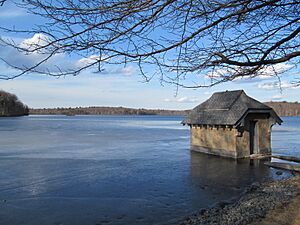Stony Brook (Charles River tributary, Weston) facts for kids
Stony Brook is a stream that mostly flows through the towns of Lincoln and Weston in Massachusetts. It then forms part of the border between Weston and Waltham. Finally, it empties into the Charles River, across from the border of Waltham and Newton.
Stony Brook has two smaller streams that flow into it, called tributaries. These are Cherry Brook and Hobbs Brook. The area of land that drains water into Stony Brook and its tributaries is called its watershed. This watershed covers about half of Lincoln and Weston, plus parts of Lexington and Waltham. Since 1887, Stony Brook has been an important water supply for the city of Cambridge.
Contents
History of Stony Brook
Stony Brook has been used by people for a long time. In the past, different types of water mills were built near where Stony Brook meets the Charles River.
Early Mills
Around 1679-1680, a mill for grinding corn was built here. Later, in about 1802, a paper mill was also set up. These mills used the power of the flowing water to operate their machinery.
Norumbega Tower
In the late 1800s, a person named Eben Norton Horsford believed that the mouth of Stony Brook was the site of an old Norse city called Norumbega. He even paid for the building of the Norumbega Tower there. This tower has a long message carved into it, describing the city he thought was once there.
Reservoirs and Water Supply
The Stony Brook area is home to three large ponds. All of these ponds were created by people, not by nature. They are very important for storing water.
Cambridge Reservoir
The Cambridge Reservoir is also known as Hobbs Pond. In 1910, a dam was built to create this reservoir. It collects water from an area of about 7.25 square miles (18.8 square kilometers). This reservoir can hold a lot of water, about 2.3 billion US gallons (8.8 million cubic meters).
Stony Brook Reservoir
The Stony Brook Reservoir is sometimes called Turtle Pond. In 1887, the city of Cambridge finished building a dam here. This dam was part of their plan to get water for the city. The Stony Brook Reservoir collects water from an area of about 23.57 square miles (61.0 square kilometers). It can store about 354 million US gallons (1.3 million cubic meters) of water.
Flint's Pond
Flint's Pond is also known as Sandy Pond. This pond was dammed to become a reservoir for the town of Lincoln. The DeCordova Museum is located on the southeast side of this pond.


